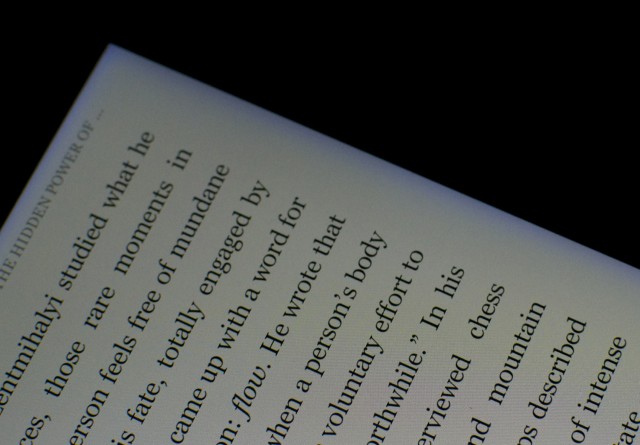When we reviewed the Kindle Fire HDX, we were impressed with its gorgeous display. High density displays are common now, but to find a display with bright, vivid, accurate colors and is something special-not what you’d expect in a productsthat costs less than $ 250. But we did see something unusual: a blue glow bleeding in from the edge of the display. We gift the pre-release hardware the benefit of the doubt, often, early hardware Is not quite at production levels. Now that the Fire HDX is in buyer’s hands, though, it seems That the blue bleed is endemic. And after doing a little research, we’ve discovered That the HDX’s stunning display and its bleed blue are related.

The Kindle Fire’s HDX 1080p, 7 “display is built by LG For movies and most UI experiences, everything looks fantastic Open the browser, However, and you’re likely to run into the problem:.. glows a faint blue haze along some edges of the screen, Especially when the screen is mostly white. That blue bleed was evident for users That read with the light background in the Kindle app. Since reading is an integral experience to all Kindles, this has Caused a Considerable amount of consternation.
Amazon seems to be trying to get ahead of consternation That, though, if you check the order page for the Kindle Fire HDX, you’ll see a little disclaimer Regarding what Amazon describes as “a blue tint around the edge of the device. ” The company usefull states that “[a] ll displays have some level of light emission around the edges, and the light on the Kindle Fire HDX 7″ is blue due to the technology used to render perfect color accuracy. “The first part of That statement is true, but it was the second part that really got us curious.
Two factors define the quality of a display: accuracy and gamut. Accuracy is what it sounds like, when asked to display red, the screen will display red, and not something a bit more purple, or orange. Gamut is a more complicated term to define Because it requires me to use the term “color space.” In order to describe colors digitally, they are numerically Characterized by the intensity of Their red, green, and blue (RGB) components. Where there are numbers, there are graphs, and where there are graphs there can be curves. If you take a set of defined colors within a few curves you have a color space, the percentage of That That A range display can produce is its gamut
.
Color spaces define the digital language of color. They allow visual artists, designers, programmers, and readers to know what is meant by “red” or “blue.” Multiple color spaces exist and overlap, though the most prevalent in the digital world is sRGB.
The sRGB color space was chosen during the CRT era. Back then, even cheap models were capable of displaying at-or-near-100 percent sRGB gamut. LCDs, though, have Suffered from various complications, somewhat owing paper to the different types of backlights used. Ideally, the backlight shouldering produce pure “white” light, so That the panel is starting with an even source from Which to filter the appropriateness colors. Solutions Involving CCFLs and arrays of individual red, green, and blue LEDs were gene rally too bulky and expensive for the TV space, let alone the mobile space.
On mobile devices, the predominant solution has Involved edge-lit “white” LEDs. Here, a blue LED emits light Which excites a yellow phosphor, and the combined “white” light is diffused across the display. Phosphors are molecules that, when exposed to energy, emit light, in this case the actual photons from the LED excite the phosphor molecules. This approach has leg refined over the last few years, Which is why mobile displays look a bit less blue today than they did in 2011. The refined process Has not improved the gamut, However. That’s because the light source is a combination of yellow and blue light, lacking both red and green elements.
A Silicon Valley advanced materials company, Nanosys, has developed a solution with an awesome name: quantum dots . The blue LEDs yellow phosphor, and the panel layer That diffuses the light are both combined Replaced by a single thin sheet embedded with microscopic red and green phosphors. Axis light from the blue LED excites the red and green phosphors, the result is a truer “white” light, Which yields an increasement in color gamut without the expense or bulk or additional colored LEDs.
Here is where we find the source of the blue light bleeding onto the display. Amazon was right to say That all LCDs leak a little light From their backlights. When quantum dots are used, the light that leaks out is intensely blue, since there’s no yellow phosphor to soften it. That blue hue will not be noticeable against dark backgrounds, but will be visible with white backgrounds. Since light leak Is not a new problem, there are improvements That can be Implemented to mitigate Their effect. These improvements add cost, though, and in a modestly priced device, we can only expect so many advances
.
If you spend a lot of time looking at white screens and might find blue bleed too distracting, then you shouldering reconsider buying a Kindle Fire HDX, or plan to mitigate the problem by using the dark mode in the reader app (and on our own site). Shoppers Should not be turned off entirely, though, the Kindle Fire HDX remains one of the best screens for your dollar, blue bleed Notwithstanding
.
No comments:
Post a Comment